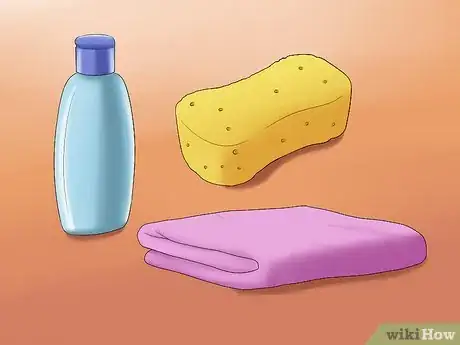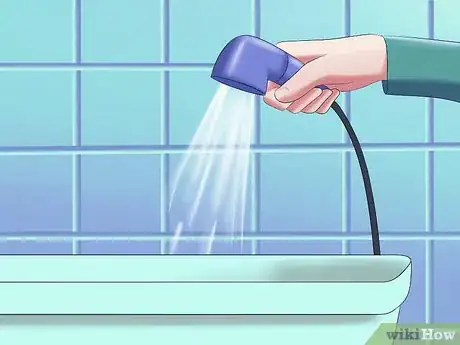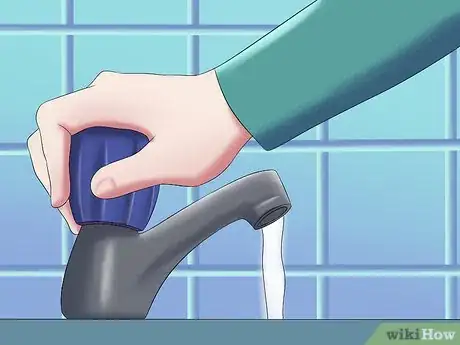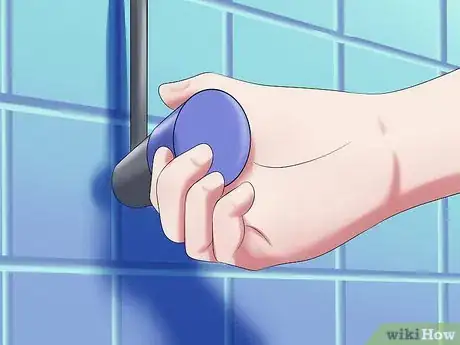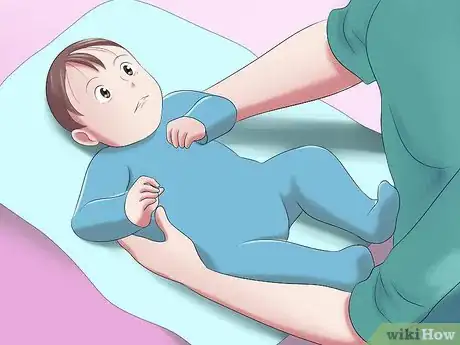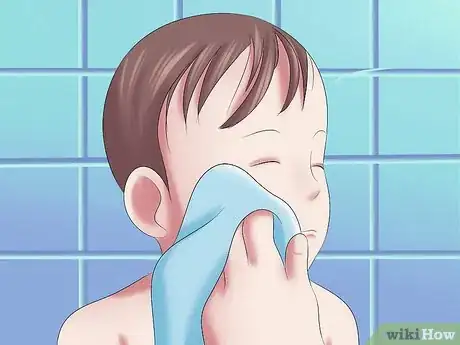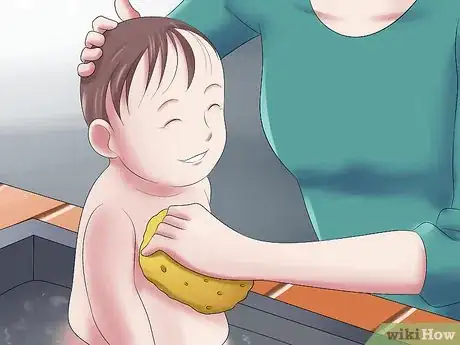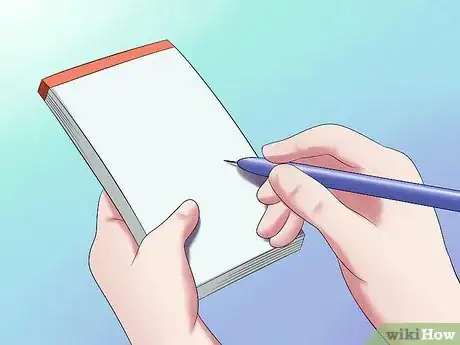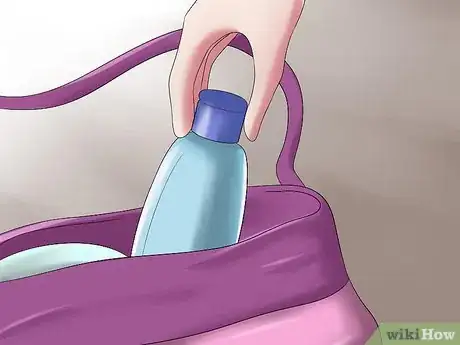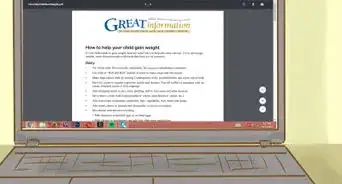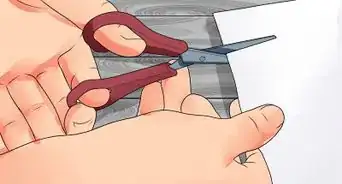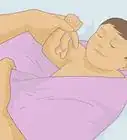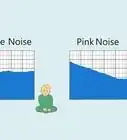This article was co-authored by Giselle Baumet. Giselle Baumet is a Mindset & Wellness Coach and the Owner of Granola Babies based in Orange County, California. With more than 16 years of experience, she specializes in helping others, particularly parents, navigate through life’s challenges. Giselle earned a BS from Rhode Island College and a Lactation Educator Certification from The University of San Diego. She also holds a Women’s Life Coach Certification from The Academy of Creative Coaching, a Transpersonal Hypnotherapist and Somatic Healer Certification from The Transpersonal Hypnotherapy Institute, a Hypnosis and Childbirth Certification from The American Hypnosis Association, and a Positive Parenting Educator Certification from Positive Discipline.
This article has been viewed 31,973 times.
Whether it is just an overnight trip or a longer vacation, it may be necessary to give a baby your baby bath while away from home. Bathing your baby can be a struggle whether or not you at home, and traveling can add another layer of complication. However, you can easily give your baby a bath while away from home as long as you prepare properly and know how to give a proper bath.
Steps
Bathing in the Tub
-
1Call ahead to your hotel to determine the best way to bathe your baby. Giving a baby a bath in a hotel room can pose all sorts of problems, so it is always best to call ahead to know what you will be dealing with.
- For example, the bathroom may not have enough floor space for you to comfortably kneel beside the tub to bathe the baby.
- In addition, although most bathrooms contain a bathtub, some hotel rooms have only a shower stall.
- When making reservations at a hotel, you should ask about the bathroom to be sure that it is appropriate for giving your baby a bath.
- If it doesn't sound like the originally planned hotel room will work, you can ask for a different room or make reservations at a different hotel.
-
2Prepare the bathing supplies to make the bath easier. While the tub is filling, you should set up the bath essentials before your baby is put in the tub.
- You should put yourself where you will be while bathing the baby and make sure that everything is easy to reach.
- If the tub is set up differently from the one at home, you should have a plan for getting the baby in and out of the tub smoothly.
- After everything is ready, you can undress the baby and proceed with the bath just as you would at home.
- Plan your baby's bath a few minutes after feeding and at a time when you can be calm and relaxed through the process. It's also essential to recognize your baby's cues so that if your baby seems fussy, you can stop the bathing process and try another time.
Advertisement -
3Rinse the tub before bathing. It might seem like a strange thing to do at a hotel or relative's home, but it may ease your mind if you at least put some water in the tub and wipe it down with a separate washcloth before giving your baby a bath.
- This is because you have no real knowledge about when the tub was cleaned last, how thoroughly it was cleaned, and what type of chemicals were used to clean it.
- Wetting the tub and wiping it down with a washcloth removes any surface dirt and chemical residue that might be present.
-
4Check the water to make sure it is safe and comfortable for your baby. Along with the actual physical arrangement of bathrooms, at both a relative's home and a hotel, there may also be a difference in how quickly the water becomes hot and the temperature that it reaches.
- This is something you won't know until you are actually getting the bath ready, but it needs to be done for every bath that the baby is given while away from home.
- The bathwater may vary in temperature from one bath to another, due to high demand from other users in the building, an old or faulty water heater, or any number of other reasons.
- Although it isn't very common, there is also the possibility that the water might not be as clean and clear as it is at home.
- For example, some older homes, and possibly hotels, may have pipework that is rusty and the rust may cause the water to be cloudy or tinged.
- This is usually cleared up by letting the water run for a few minutes before plugging the drain in the tub.
- When starting the bath, be sure to hold your baby close to your body as you insert one foot and let your baby experience the water. Always keep a hand on your baby, since your touch is comforting to them.
Bathing in the Shower
-
1Take a shower with your baby if there are no other options. You can actually go into the shower stall with your baby to wash them there.
- When the shower is used, it is important to check the water temperature and the force of the spray.
-
2Turn down the shower spray. If the water spray is very strong, the faucet can be turned down so that less water exits the shower head.
- Babies do not react well to high-powered water, so it is always best to make sure that the shower puts out more of a light drizzle than a strong blast.
-
3Block the water from directly hitting your baby. Since most babies do not like the feeling of the water hitting their skin, especially their face, you can use their own body to block the shower spray.
- Use your hand to guide the water onto the baby.
- Cup your hands and rinse your baby off by gentle dumping cupped water onto them.
-
4Keep a tight hold on your baby when standing. Keep in mind that the baby will be slippery while wet, so it is important to be sure that you have a good hold on your baby.
- One of the easiest poses for washing a baby in the shower is for you to have the baby's back against your abdomen with your arm wrapped around the baby's abdomen.
- In this position, nearly all of the baby's body can be reached easily and you can gently press the baby against your abdomen if they start to slip.
Bathing With a Sponge
-
1Find a warm, flat surface to avoid using the tub. To give your baby a sponge bath, use the sink for the bathwater, but instead of putting your infant in the sink, hold them on the counter and give them a sponge bath.
- This allows you to give an infant a bath without the fear of using a large tub.
- If you are not comfortable holding your infant up high in the shower, this can be a great option.
-
2Lay your your baby on his or her back on a towel. When you're ready to begin the sponge bath, undress your baby and wrap him or her in a towel.
- Make sure to put your baby on a soft blanket, towel or pad that you've prepared.
-
3Wipe your baby's face with a washcloth. Wet your washcloth, wring out the excess water and begin washing your baby.
- Wash your baby's face first, making sure to be gentle.
- Use a damp cotton ball or cloth to wipe each eyelid, from the inside to the outside corner.
-
4Wash your baby's body. Wash your baby's body with a washcloth or sponge to make sure they are cleaned thoroughly.
- When you clean your baby's body, plain water is OK.
- If your baby is especially dirty, use a mild moisturizing soap.
- Make sure to take note of creases under the arms, behind the ears, around the neck and in the diaper area.
- Wash between your baby's fingers and toes.
-
5Keep your baby warm in a towel or blanket during washing. Since your baby is not sitting in warm water during a sponge bath, it is important to wrap a towel around the baby to keep them from getting chilled.
- You should keep one hand on the baby and just expose the baby's body parts as they are being washed.
Maintaining a Travel Kit
-
1Make a list of the proper toiletries to prepare for packing. It is very annoying to get part way through your baby's bath and suddenly realize that you forgot something, especially if you are alone with your baby and the item is not within your reach.
- In order to prevent this from happening while you are away from home, you should make a list of everything you use while you are giving your baby a bath at home before you leave.
- Of course, to make traveling easier, only the essentials should be packed.
- The list should include your baby's soap, shampoo, washcloth, towel, and hairbrush or comb.
- Another thing you should pack is a bath mat, to prevent your baby from sliding on the bottom of the tub.
- Although not necessary, some parents also choose to pack a few bath toys for older babies.
- Try keeping the list in a small tote or other easily carried bag where all of the bath essentials can be packed and kept together on the trip.
- This makes it very convenient to just grab the tote when it is time for the baby's bath.
- The tote can even be packed into another piece of luggage to keep it from getting lost while traveling.
-
2Take note of the different amenities at your travel destination to plan your bath. Whether you are staying with relatives or renting lodging in a hotel, the bathroom amenities are more than likely going to be different than those that you are used to at home.
- If you prefer to give your young infant a bath in a sink, there may be a problem with the faucet being at a poor angle.
- If this is the case, it may be necessary to resort to the tub.
- If you are worried about your infant being in the tub, you can get in the tub water with the baby to support them during the bath.
-
3Gather the items after the bath to stay organized. After the baby is bathed, dressed, and in a safe place, you need to drain the tub and gather up the baby's bath essentials.
- Wet items, like the washcloth and towel, need to be hung up somewhere to dry.
- The bath mat can be laid out flat on a towel to dry overnight.
- If it is just a one night stay, these things should be put somewhere obvious so that they are not left behind.
- The rest of the bath essentials can be packed back into the tote so they are ready for departure.
- If toys were used in the tub, a mesh cloth bag can be used to help them dry quickly without taking up much space.
- The bag of toys can be hung from the faucet, a hook, or a towel rod so that the toys can drip dry.
Warnings
- Once the bath is complete, make sure to lay the baby down in your soft blankets or towels and carefully dry them.⧼thumbs_response⧽

